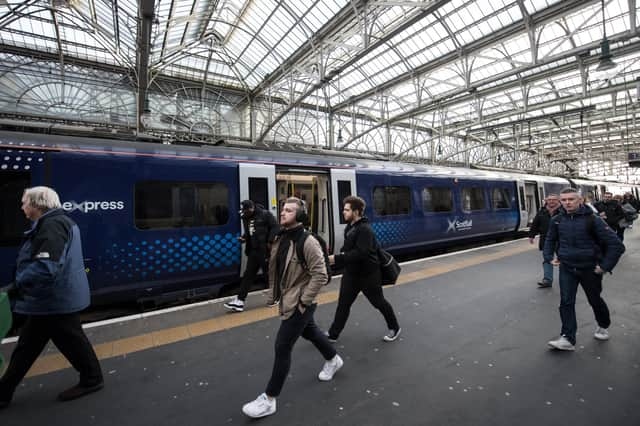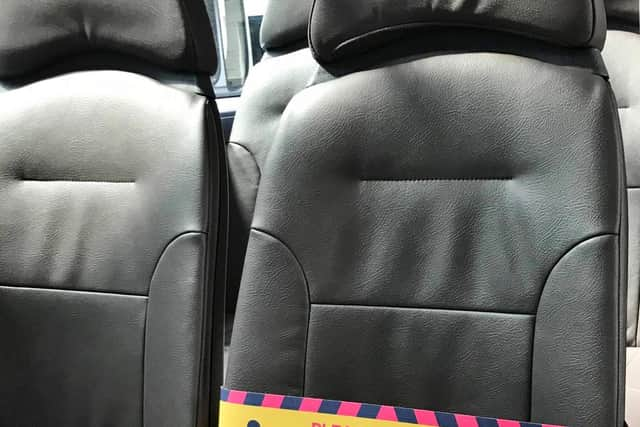Bus and train passengers told to bring own face coverings


Transport secretary Michael Matheson told MSPs using face coverings was vital because physical distancing while travelling “can be difficult”.
They should be worn in buses, trains, trams and the Glasgow Subway, in taxis and private hire vehicles, and on ferries other than outside areas.
The measure also includes at rail and bus stations.


Young children exempt
Advertisement
Hide AdAdvertisement
Hide AdHowever, young children are exempt along with people with health conditions that would make it “inappropriate”.
Mr Matheson said: “People should, and are expected to wear face coverings as an additional measure when using public transport, and as a consideration to staff and fellow passengers.
“Please come prepared with your own face covering when using public transport.
“Of course, there will be situations where this isn’t practicable.”
Passengers are advised that where 2m distancing is not possible, to avoid physical contact and face away from other people, and keep it as short as possible.
First Minister Nicola Sturgeon told today’s daily briefing that whether face coverings should become mandatory on public transport would be "kept under review".
However, she said it would be difficult for some people to wear them, such as those with health conditions like asthma.
The measure was announced as part of the Scottish Government’s transport transition plan for public transport, published today by Mr Matheson.
Concerns over enforcement
Advertisement
Hide AdAdvertisement
Hide AdBut Scottish Labour transport spokesman Colin Smyth said: “If the government believes face coverings are necessary to stop the further spread of Covid-19, then they must explain how this will be enforced.
“Under this guidance, there is nothing to stop anyone getting on public transport without a face covering, not just those who cannot wear face coverings for practical reasons.
“Transport staff need the assurance they will not be forced into a position where they have to put themselves at risk in an attempt to enforce the official guidance.”
Scottish Conservatives transport spokesman Dean Lockhart welcomed the plans but said the safety of passengers and workers must be guaranteed.
He said: “In this respect there are still a number of unanswered questions around the supply of PPE for transport workers and a lack of clarity on enforcement of social distancing guidelines.”
Mr Matheson also announced the Spaces for People fund for temporary cycle paths and pavements would be increased from £10 million to £30m after the original budget was oversubscribed with applications from councils.
All but six of Scotland’s 32 local authorities have registered interest in funding, with a total of £12 million allocated to nine councils so far.
Measures introduced already include several roads being closed to traffic in Edinburgh and a new one-mile cycle lane beside the Clyde in Glasgow city centre.
Advertisement
Hide AdAdvertisement
Hide AdJohn Lauder, deputy chief executive of path developers Sustrans, which is co-ordinating the initiative, said: “This additional funding will allow all local authorities and statutory bodies who want to to apply and secure funding to help provide a positive and lasting change in our walking, cycling and wheeling habits as we transition out of lockdown.
"And we encourage the public to contact their local authority where they can see the need for wider pavements and safer roads and streets for cycling and wheeling.”
Mr Matheson called on employers to stagger start times for staff to reduce the number of people travelling at peak times.
ScotRail capacity cut to 12 per cent of normal
He said bus and trains are expected to be able to carry, at most, only one quarter of the normal number of passengers because of the need for physical distancing.
However, capacity on ScotRail trains will be reduced to just 12 per cent of normal, while it will be 17-18 per cent on CalMac ferries and 15-20 per cent on NorthLink ferries.
This could have a “significant impact on timetables given the need for longer turnarounds at some ports”, the transport plan warned.
Mr Matheson said some bus operators such as First Glasgow had increased capacity by operating double deckers rather than single deckers on some routes, and increasing service frequencies.
Advertisement
Hide AdAdvertisement
Hide AdThe minister said consideration was being given to passengers having to book in advance for longer ScotRail journeys, like other train operators such as LNER.
Physical distancing and increased cleaning are also planned for bus and rail stations, ferry terminals and airports.
Passengers are asked not to eat or drink while travelling, except on long journeys, and not to congregate “near entrances, exits, under canopies, at bus stops, on platforms or outside of stations”.
Mr Matheson said discussions were taking place with bus operators across the country over potential support because most would run at a loss because of their significantly reduced capacity.
‘Extreme uncertainty’ over travel demand
A four-phase plan for Scotland’s emergence from lockdown was published last week by ministers, but the transport plan admitted there was an “extremely high level of uncertainty in estimating levels of travel demand” for each stage.
It said that for now, people should continue to work from home if possible, keep travel to local areas and walk or cycle rather than use public transport, and avoid driving at busy times.
Planning will focus particularly on the impact on women, who are likely to be disproportionately affected because they rely on public transport much more than men.
A message from the Editor:
Thank you for reading this story on our website.
While I have your attention, I also have an important request to make of you.
Advertisement
Hide AdAdvertisement
Hide AdWith the coronavirus lockdown having a major impact on many of our advertisers - and consequently the revenue we receive - we are more reliant than ever on you taking out a digital subscription.
Subscribe to scotsman.com and enjoy unlimited access to Scottish news and information online and on our app.
With a digital subscription, you can read more than 5 articles, see fewer ads, enjoy faster load times, and get access to exclusive newsletters and content.
Visit https://www.scotsman.com/subscriptions now to sign up.
Our journalism costs money and we rely on advertising, print and digital revenues to help to support them.
By supporting us, we are able to support you in providing trusted, fact-checked content for this website.
Joy Yates
Editorial Director
Comments
Want to join the conversation? Please or to comment on this article.